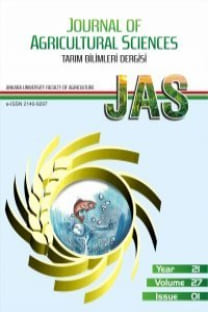Use of Principal Coordinate Analysis for Measuring GE Interactions in Rain-Fed Durum Wheat Genotypes
Use of Principal Coordinate Analysis for Measuring GE Interactions in Rain-Fed Durum Wheat Genotypes
___
- Akcura M, Kaya Y & Taner S (2009). Evaluation of durum wheat genotypes using parametric and nonparametric stability statistics. Turkish Journal of Field Crops 14(2): 111-122
- Becker H C & Leon J (1988). Stability analysis in plant breeding. Plant Breeding 101: 1-23
- FAO (2015). FAOSTAT, Data stat year 2015. Food agriculture organization http://faostat.fao.org/ (verifid 2 Feb. 2015), Rome, Italy
- Finlay K W & Wilkinson G N (1963). The analysis of adaptation in a plant-breeding programme. Australian Journal of Agricultural Research 14: 742-754
- Flores F, Moreno M T, Martinez A & Cubero J I (1996). Genotype × environment interaction in faba bean:Comparison of AMMI and principal coordinate models. Field Crops Research 47: 117-127
- Gower J C (1966). Some distance properties of latent root and vector methods used in multivariate analysis. Biometrika 53: 325-338
- Ibanmez M A, Direnzo M A, Samame S S, Bonamico N C & Poverene M M (2001). Genotype–environment interaction of lovegrass forage yield in the semi-arid region of Argentina. Journal of Agricultural Science 137: 329-336
- Ilker E, Geren H, Unsal R, Sevim I, Aykut Tonk F & Tosun M (2011). AMMI-biplot analysis of yield performances of bread wheat cultivars grown at diffrent locations. Turkish Journal of Field Crops 16(1): 64-68
- Karimizadeh R, Mohammadi M, Armion M, Shefazadeh M K & Chalajour H (2012a). Determining heritability, reliability and stability of grain yield and yield-related components in durum wheat (Triticum durum L.). Bulgarian Journal of Agricultural Science 18(4): 595-607
- Karimizadeh R, Mohammadi M, Shefazadeh M K, Mahmoodi A A, Rostami B & Karimpour F (2012b). Relationship among and repeatability of ten stability indices for grain yield of food lentil genotypes in Iran. Turkish Journal of Field Crops 17(1): 51-61
- Karimizadeh R, Mohammadi M, Sabaghnia N & Shefazadeh M K (2012c). Using Huehn’s Nonparametric Stability Statistics to Investigate Genotype × Environment Interaction. Notulae Botanicae Horti Agrobotanici Cluj-Napoca 40(1): 293-301
- Karimizadeh R, Mohammadi M, Sabaghnia N, Mahmoodi A A, Roustami B, Seyyedi F & Akbari F (2013). GGE biplot analysis of yield stability in multi-environment trials of lentil genotypes under rainfed condition. Notulae Scientia Biologicae 5(2): 256-262
- Karimizadeh R, Asghari A, Chinipardaz R, Sofalian O & Ghaffri A (2016). Determining yield stability and model selection by AMMI method in rain-fed durum wheat genotypes. Turkish Journal of Field Crops 21(2): 174-183
- Leon N, Jannink J L, Edwards J W & Kaeppler S M (2016). Introduction to a special issue on genotype by environment interaction. Crop Science 56: 2081-2089
- Ma J, Zhang C Y, Yan G J & Liu C J (2013). Improving yield and quality traits of durum wheat by introgressing chromosome segments from hexaploid wheat. Genetics and Molecular Research 12: 6120- 6129
- Medina J L, Moore P P, Shanks C H, Gil F F & Chandler C K (1999). Genotype × environment interaction for resistance to spider mites in Fragaria. Journal of the American Society for Horticultural Science 124: 353-357
- Mladenov V, Banjac B & Milosevic M (2012). Evaluation of yield and seed requirements stability of bread wheat (Triticum aestivum L.) Via AMMI Model. Turkish Journal of Field Crops 17(2): 203-207
- Mohammadi M, Karimizadeh R, Sabaghnia N & Shefazadeh M K (2012). Genotype × Environment interaction and yield stability analysis of new improved bread wheat genotypes. Turkish Journal of Field Crops 17(1): 67-73
- Mohebodini M, Karimizadeh R, Mohammadi M & Sabaghnia N (2012). Principal coordinates analysis of genotype × environment interaction in grain yield of lentil genotypes. Agriculture and Forestry 57: 93-107
- Ruttan V W (1998). Meeting the food needs of the world, In: V W Ruttan (Eds.), International agricultural research: four papers, Department of Applied Economics, University of Minnesota, Minneapolis, MN, pp. 98-104
- Sabaghnia N, Karimizadeh R & Mohammadi M (2012). Genotype by environment interaction and stability analysis for grain yield of lentil genotypes. Žemdirbystė -Agriculture 99(3): 305-312
- Sabaghnia N, Mohammadi M & Karimizadeh R (2013a). Principal coordinate analysis of genotype × environment interaction for grain yield of bread wheat in the semi-arid regions. Genetika 45(3): 691-701
- Sabaghnia N, Karimizadeh R & Mohammadi M (2013b). Principal coordinate analysis of yield stability performances of grain yield in durum wheat genotypes. Jordan Journal of Agricultural Sciences 9(4): 544-560
- Tabachnick G B & Fidell L S (2012). Using multivariate statistics. Pearson Publishers, India
- VSN International (2009) GENSTAT Committee, GENSTAT 12 release 1, Reference Manual. Clarendon Press, Oxford, UK
- Westcott B (1986). Some methods of analyzing genotypeenvironment interaction. Heredity 56: 243-253
- Zuur A F, Leno E N & Smith G M (2007). Statistics for biology and health-analyzing ecological data, Springer Publishers, New York
- Yayın Aralığı: 4
- Yayıncı: Ankara Üniversitesi Basımevi
Use of Principal Coordinate Analysis for Measuring GE Interactions in Rain-Fed Durum Wheat Genotypes
Rahmatollah KARIMIZADEH, Ali ASGHARI, Omid SOFALIAN, Rahim CHINIPARDAZ, Abdolali GHAFFARI, Kamal SHAHBAZI, Tahmasb HOSSEINPOUR, Hassan GHOJOG, Mohammad ARMION
Identifiation of Hordeum spontaneum Genotypes Resistant to Net Blotch Disease
Arzu ÇELİK OĞUZ, Rukiye MURAT DURAN, Kürşad ÖZBEK, Aziz KARAKAYA
Jale KORUN, Mesut YILMAZ, Mehmet GÖKOĞLU, Yağmur ÇELİK
Arzu Çelik Oğuz, Aziz Karakaya, Rukiye Murat Duran, Kürşad Özbek
Fatemeh BAREKATİ, Eslam MAJİDİ HERVAN, Amir Hossein SHİRANİ RAD, Ghorban NOOR MOHAMADİ
Saqib ALI, Ishrat NAZ, Muhammad ALAMZEB, Mamoon URRASHID
Saqib Ali, İshrat NAZ, Muhammad ALAMZEB, Mamoon URRASHİD
Hasan SARISU, Ömer Faruk KARAMÜRSEL, Fatma Pınar ÖZTÜRK, İsmail DEMİRTAŞ, Hakkı KOÇAL, İbrahim GÜR, Özlem CENGİZ, İsmail ŞEVİK
Mesut YILMAZ, Mehmet GÖKOĞLU, Jale KORUN, Yağmur Saadet ÇELİK
İlhan TURGUT, 2. duran ZARARSIZ, 3. semra YANIKOĞLU, 4. leyla ÖZTÜR AKAR, 5. sezgin KIZIK, 6. burak BİLGİN
